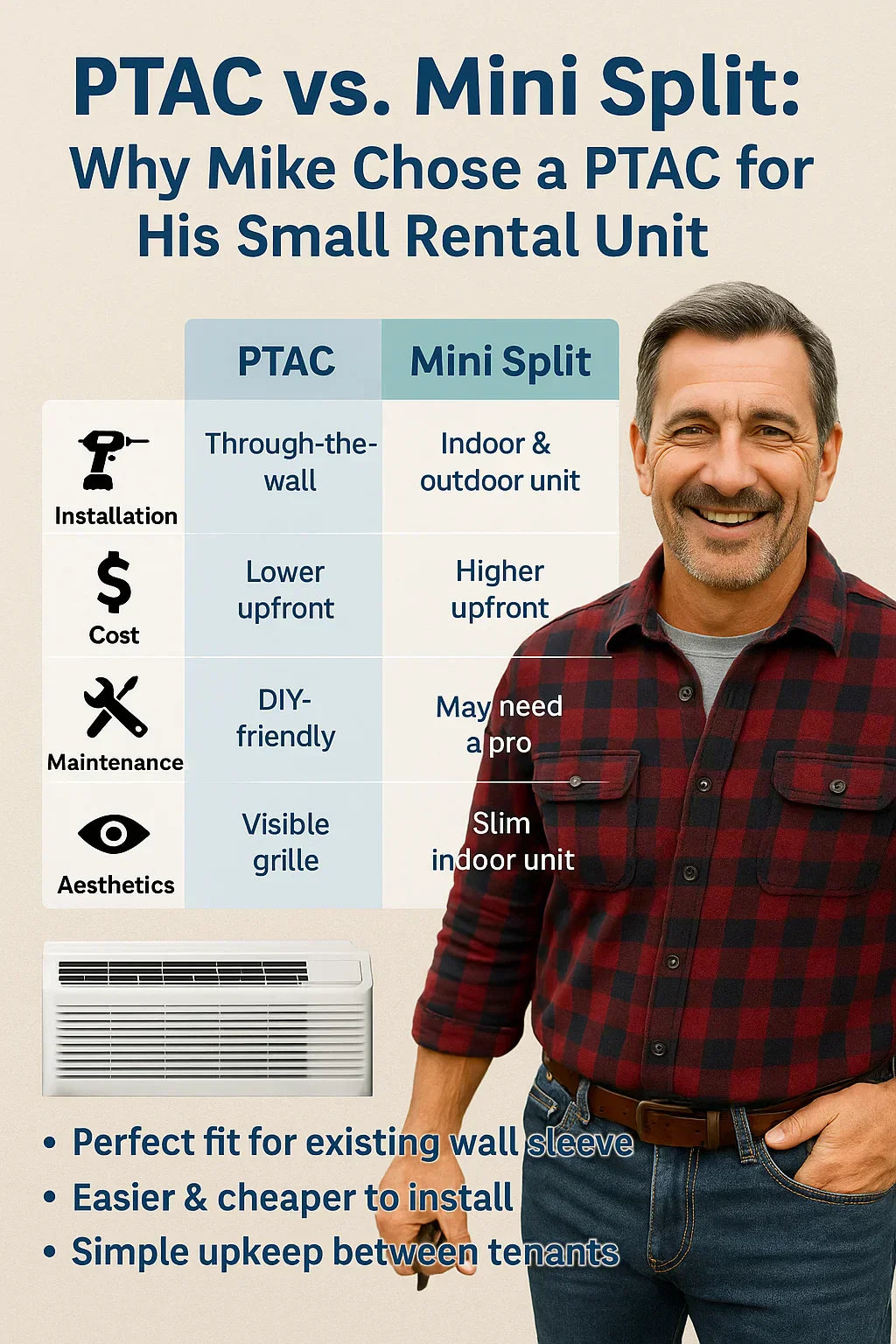I. Introduction: Mike's Dilemma
When Mike took over managing his small rental unit, a 500 sq ft studio apartment tucked behind his main home, he faced a crucial HVAC decision. The old wall unit was barely cooling in summer and completely unreliable in winter. Mike wanted something efficient, budget-friendly, and easy to install without turning the place into a construction zone. He narrowed it down to two options: a PTAC (Packaged Terminal Air Conditioner) or a ductless mini split. After researching, comparing, and running the numbers, Mike chose a PTAC. Here’s why.
II. What’s the Difference? PTAC vs. Mini Split at a Glance
PTAC (Packaged Terminal Air Conditioner): Common in hotels and rentals, these all-in-one units sit in a wall sleeve and provide both heating and cooling.
Mini Split (Ductless Heat Pump): Consists of one or more wall-mounted indoor units and an outdoor compressor, known for high efficiency and zoning flexibility.
Comparison Chart:
| Feature | PTAC | Mini Split |
|---|---|---|
| Installation | Through-the-wall | Wall-mounted + outdoor unit |
| Cost | Lower upfront | Higher upfront |
| Maintenance | DIY-friendly | Often requires a technician |
| Appearance | Visible front grille | Sleek indoor unit |
| Use Case | Rentals, hotels | Homes, additions, offices |
III. Installation Realities: Why PTAC Made More Sense for Mike
Mike's rental unit didn’t have much outdoor space. Installing a mini split condenser would mean pouring a new pad or wall-mounting the condenser above the unit’s entrance. Plus, his local HOA had restrictions on visible exterior equipment.
The old wall sleeve was already there, and Mike realized he could install a new PTAC into that same space with minimal structural work. A basic 120V PTAC with electric heat slid right in. Total install time? About 90 minutes with a helper.
IV. Cost Breakdown: PTAC vs. Mini Split
PTAC System Costs:
-
GE Zoneline PTAC: $950
-
Wall sleeve and rear grille: $125
-
DIY install: $0 labor
-
Total: ~$1,075
Mini Split System Costs (Estimate):
-
9k BTU Single Zone System: $1,500
-
Labor & electrical hookup: ~$2,000
-
Additional permits/inspection: ~$300
-
Total: ~$3,800
For Mike, the PTAC won hands-down when it came to payback period. It was up and running in one afternoon without contractor delays.
V. Energy Efficiency & Performance
Mini splits typically boast SEER2 ratings of 20 or more, making them champions in efficiency. But Mike found that his Energy Star-rated PTAC with a 12.0 EER still performed surprisingly well for a space that small.
He added a simple programmable wall thermostat, weather-stripped the sleeve, and insulated around the unit. The result? Utility bills remained consistent and manageable, even in January and July.
VI. Noise, Comfort & Control
Mike knew PTACs were slightly noisier, especially when the fan kicked in. But for a rental unit where tenants expect basic function, it was a fair trade-off. He chose a model with low-noise operation and sealed any wall gaps to further dampen sound.
Control was easy. His unit included:
-
A remote control
-
Onboard digital thermostat
-
Optional wall-mounted smart control panel
For his tenant’s needs, it was more than sufficient.
VII. Maintenance & Durability
Mike prioritized ease of upkeep. He didn’t want to call in a tech every time a filter clogged. With the PTAC:
-
The washable filter pops out from the front
-
Coils are accessible for DIY cleaning
-
Drain pan is easy to check and flush
He created a quarterly maintenance checklist:
-
Clean filter
-
Check and clean coils
-
Inspect power cord and receptacle
-
Test heating and cooling modes
His unit has run smoothly through 18 months of tenant use so far.
VIII. What Would Make Mike Choose a Mini Split Instead?
Mike admits that if the space were larger—say, 800+ sq ft—he might have chosen a mini split for better zone control and quieter operation. If he lived in the unit full-time, the comfort perks might outweigh the cost.
Rebates might also swing things. In his state, there were no utility incentives for PTACs, but mini splits could qualify for a $500 tax credit. Still, the math didn’t work in this case.
"If I lived there, I might’ve gone with a mini split. But for a tenant and a small space? PTAC all the way."
IX. Mike’s PTAC Recommendation for Rentals
He ended up choosing a GE Zoneline model with:
-
Electric heat kit (no need for gas hookup)
-
12.0 EER and Energy Star rating
-
Slide-out chassis
-
Freeze protection and auto-restart
Installation Tips from Mike:
-
Use a quality wall sleeve (metal, not plastic)
-
Always install the rear grille for weather protection
-
Seal the sleeve perimeter with spray foam or caulk
X. Conclusion: Mike’s Rental, His Rules
Mike’s PTAC decision boiled down to simplicity, budget, and reliability. For his 500 sq ft rental, it checked every box.
If you’re debating between a PTAC and a mini split for a small space or income property:
-
Start by measuring your space
-
Consider how often you’ll need access for repairs
-
Don’t forget to weigh exterior constraints
Need help deciding? Use The Furnace Outlet Sizing Guide or upload photos using the Quote by Photo Tool to get a professional recommendation tailored to your setup.
In the next topic we will know more about: Do Best-Selling PTACs Qualify for 2025 Energy Rebates or Tax Credits?







